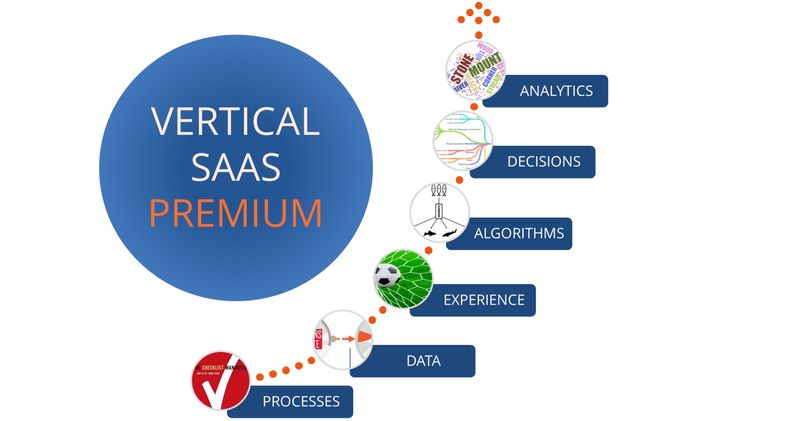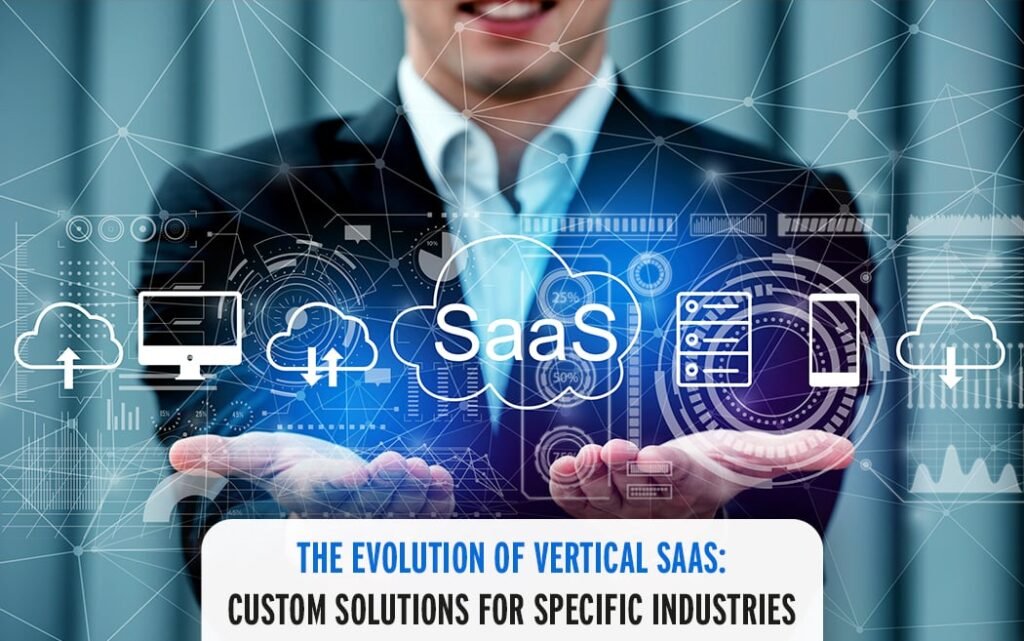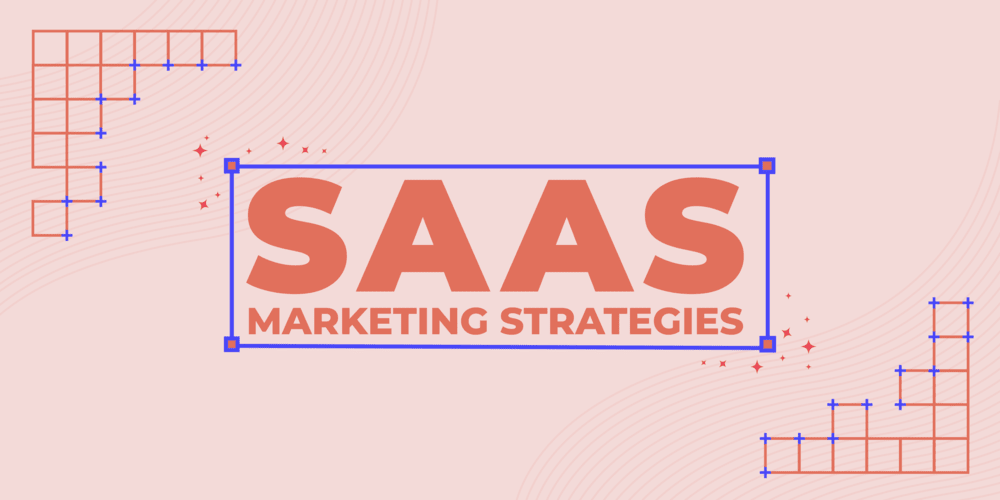Vertical SaaS (Software as a Service) targets specific industry needs. It offers specialized solutions tailored for niche markets.
Vertical SaaS focuses on delivering industry-specific applications. Unlike horizontal SaaS, which serves a broad range of industries, vertical SaaS tailors its services to meet the unique demands of particular sectors such as healthcare, finance, or retail. This specialization allows businesses to gain more value from software designed to address their precise challenges.
Vertical SaaS providers often have deep industry knowledge, which helps in creating more relevant and effective solutions. These solutions can enhance operational efficiency, regulatory compliance, and customer engagement within the targeted industry. As a result, vertical SaaS is becoming increasingly popular among businesses looking for tailored and efficient software solutions.
Vertical Saas Basics
Vertical SaaS, or Vertical Software as a Service, focuses on providing specialized software solutions tailored to specific industries. Unlike horizontal SaaS, which offers broad services across various sectors, vertical SaaS dives deep into the unique needs of a particular market. Understanding the basics of vertical SaaS can help businesses choose the right software to meet their industry-specific requirements.
Industry Focus
Vertical SaaS targets specific industries, offering solutions that cater to their unique challenges and requirements. This specialization ensures that the software is highly relevant and effective for the target audience. Key industries benefiting from vertical SaaS include:
- Healthcare: Solutions for patient management, electronic health records, and telemedicine.
- Real Estate: Tools for property management, listings, and client communication.
- Retail: Inventory management, point-of-sale systems, and customer loyalty programs.
- Finance: Financial planning, risk management, and compliance solutions.
These industry-specific solutions often include features and functionalities that are not found in generic software, making them indispensable for businesses within those sectors. For instance, a healthcare SaaS might offer HIPAA compliance features, while a finance SaaS could provide advanced analytics for financial forecasting.
Vertical SaaS also allows companies to stay updated with industry trends and regulations. Since the software is designed with the industry’s specifics in mind, it can adapt quickly to any changes in the market or regulatory environment. This adaptability ensures that businesses remain compliant and competitive.
Business Model
The business model of vertical SaaS is different from horizontal SaaS. Vertical SaaS companies usually adopt a subscription-based model, offering various tiers of service to meet the needs of different business sizes and types. Here are some common features of the vertical SaaS business model:
- Subscription Tiers: Basic, Professional, and Enterprise plans to cater to small, medium, and large enterprises.
- Customization Options: Tailored solutions to meet specific business needs and workflows.
- Integration Capabilities: Seamless integration with existing industry-specific tools and platforms.
Vertical SaaS providers often offer customer support and training services as part of their subscription plans. This ensures that businesses can maximize the use of the software and achieve their goals more efficiently.
Another key aspect of the vertical SaaS business model is the focus on long-term customer relationships. Since the software is highly specialized, customers are more likely to stay loyal and renew their subscriptions. This loyalty results in a predictable revenue stream for the SaaS provider.
In summary, the business model of vertical SaaS is designed to provide high-value, industry-specific solutions that foster long-term customer relationships and ensure business success.

Credit: diligencevault.com
Key Benefits
Vertical SaaS refers to software solutions designed for specific industries or niches. Unlike horizontal SaaS, which caters to a wide range of industries, vertical SaaS targets particular sectors such as healthcare, finance, or retail. Understanding the key benefits of Vertical SaaS can help businesses make informed decisions and reap the most value from these specialized solutions.
Tailored Solutions
One of the primary benefits of Vertical SaaS is its ability to offer tailored solutions. These solutions are designed to meet the unique needs of specific industries, ensuring that all features and functionalities align with the industry’s demands. For example, healthcare Vertical SaaS might include:
- Patient management systems
- Electronic health records (EHR)
- Telemedicine capabilities
In contrast, a Vertical SaaS for retail might focus on:
- Inventory management
- Point of sale systems
- Customer relationship management (CRM)
These tailored solutions lead to higher adoption rates among users as the software feels more intuitive and relevant to their daily tasks. Additionally, businesses often experience reduced training time and lower implementation costs because the software is already aligned with their industry standards and workflows.
Below is a table summarizing the tailored features for different industries:
| Industry | Key Features |
|---|---|
| Healthcare | Patient management, EHR, Telemedicine |
| Retail | Inventory management, POS, CRM |
| Finance | Accounting, Risk management, Compliance tools |
Enhanced Efficiency
Vertical SaaS solutions also drive enhanced efficiency within organizations. Because these solutions are designed for specific industries, they include automation of industry-specific tasks. This leads to significant time savings and allows employees to focus on more strategic activities.
For instance, in the finance sector, Vertical SaaS can automate:
- Invoice processing
- Risk assessments
- Regulatory compliance
In the hospitality industry, it might streamline:
- Booking management
- Guest services
- Housekeeping schedules
These efficiencies often translate to cost savings. Businesses can reduce the number of manual processes, leading to fewer errors and faster turnaround times. Enhanced efficiency also means improved customer satisfaction as services are delivered more quickly and accurately. Ultimately, this can lead to increased revenue and growth opportunities for businesses leveraging Vertical SaaS solutions.
Market Examples
Vertical SaaS, or Vertical Software as a Service, refers to specialized software solutions tailored to meet the specific needs of a particular industry. Unlike horizontal SaaS, which serves a broad range of industries, Vertical SaaS focuses on niche markets. Understanding the market examples of Vertical SaaS can provide a clearer picture of its impact. Let’s explore some key markets where Vertical SaaS is making waves.
Healthcare
The healthcare industry benefits immensely from Vertical SaaS solutions. These specialized software systems cater to the unique requirements of healthcare providers, patients, and administrative staff.
- Electronic Health Records (EHR): Streamlines patient data management and ensures easy access to medical histories.
- Telemedicine Platforms: Facilitates remote consultations and patient monitoring, especially useful in rural areas.
- Appointment Scheduling Systems: Simplifies the booking process for both patients and healthcare providers.
- Billing and Insurance Processing: Automates billing workflows and insurance claims management.
| Company | Solution | Description |
|---|---|---|
| Epic Systems | EHR | Comprehensive electronic health records for large healthcare systems. |
| Teladoc Health | Telemedicine | Provides virtual healthcare and telemedicine services. |
| Zocdoc | Appointment Scheduling | Online service for booking doctor appointments. |
Finance
The finance sector also sees significant advantages from Vertical SaaS solutions. These tools help financial institutions, banks, and fintech companies streamline operations and enhance customer experiences.
- Risk Management: Helps in assessing and managing financial risks effectively.
- Regulatory Compliance: Ensures adherence to complex financial regulations and standards.
- Fraud Detection: Utilizes advanced algorithms to detect and prevent fraudulent activities.
- Customer Relationship Management (CRM): Enhances customer service and engagement through tailored CRM solutions.
| Company | Solution | Description |
|---|---|---|
| BlackLine | Financial Close Management | Automates and streamlines the financial close process. |
| Plaid | API for Financial Services | Provides a secure API for connecting financial apps to user bank accounts. |
| Kabbage | Small Business Loans | Offers an automated platform for small business loans and credit. |

Credit: www.singlegrain.com
Comparison With Horizontal Saas
Vertical SaaS is designed for specific industries, providing tailored solutions that address unique business needs. In contrast, Horizontal SaaS offers more generalized software solutions that cater to a broad range of industries. This comparison will delve into the differences between these two types of SaaS products by examining their target audience and customization levels.
Target Audience
Vertical SaaS focuses on niche markets, serving industries like healthcare, finance, or real estate. The software is designed to meet the specific needs of these sectors. This means that each vertical SaaS product is highly specialized.
- Healthcare: Electronic Health Records (EHR) systems, telemedicine platforms.
- Finance: Investment management tools, accounting software.
- Real Estate: Property management software, MLS systems.
On the other hand, Horizontal SaaS targets a wide range of industries. The software provides general solutions that can be applied across different business types. Examples include:
- Customer Relationship Management (CRM): Salesforce, HubSpot.
- Human Resources (HR): Workday, BambooHR.
- Project Management: Asana, Trello.
While vertical SaaS products are more focused, horizontal SaaS products aim to serve multiple industries with their versatile applications.
Customization Levels
Vertical SaaS offers a high level of customization to fit the specific needs of its target industry. This makes the software more efficient for users within that niche. For example, a vertical SaaS solution for healthcare might include:
- Custom modules for patient records.
- Specialized reporting tools for medical compliance.
- Integration with medical devices and systems.
In contrast, Horizontal SaaS provides broader customization options that can be adapted to various industries. The customization is more general and not industry-specific. For instance, a horizontal SaaS CRM might offer:
- Customizable dashboards.
- Flexible reporting tools.
- Wide range of integrations with other software.
The table below summarizes the customization levels of both types of SaaS:
| SaaS Type | Customization Level |
|---|---|
| Vertical SaaS | High, industry-specific |
| Horizontal SaaS | Broad, general |
Overall, vertical SaaS provides specialized solutions with deep customization, while horizontal SaaS offers flexible tools that can be adjusted for various needs.
Challenges Ahead
Vertical SaaS (Software as a Service) refers to cloud-based solutions tailored for specific industries. While these specialized tools offer targeted functionalities, they come with unique challenges. Understanding these challenges can help businesses navigate the complexities ahead.
Limited Scope
Vertical SaaS solutions often face the challenge of limited scope. These tools are designed to address specific industry needs, which can restrict their applicability. Businesses may find that the software lacks the flexibility to adapt to broader requirements. This limited scope can result in:
- Narrow functionality: Features are tailored to specific tasks, leaving out general capabilities.
- Scalability issues: As businesses grow, the software might not support new needs.
- Customization limitations: Adapting the software for unique business models can be difficult.
Consider the following table that highlights the pros and cons of Vertical SaaS’s limited scope:
| Pros | Cons |
|---|---|
| Highly specialized features | Restricted general functionality |
| Improved efficiency for specific tasks | Challenges in scaling |
| Better compliance with industry standards | Customization difficulties |
Integration Issues
Integration issues are another significant challenge for Vertical SaaS. These solutions often need to work alongside other software systems, but compatibility can be a problem. Businesses may face:
- Data silos: Isolated data can hinder overall business insights.
- Complex integration processes: Connecting Vertical SaaS with existing systems can be cumbersome.
- Increased costs: Integration often requires additional resources and expenses.
To better understand these integration challenges, let’s look at some common scenarios:
| Scenario | Challenge |
|---|---|
| Connecting with CRM systems | Data mismatches and synchronization issues |
| Integrating with ERP solutions | Complex setup and maintenance |
| Linking with marketing platforms | Inconsistent data flow and reporting |
Addressing these integration challenges requires careful planning and investment. Businesses should evaluate their existing systems and ensure the Vertical SaaS can seamlessly integrate to maximize efficiency and minimize disruptions.
Growth Trends
Vertical SaaS, or Vertical Software as a Service, refers to software solutions designed for specific industries. These solutions cater to niche markets with unique needs. Vertical SaaS has seen significant growth, driven by businesses seeking tailored solutions. Understanding growth trends is crucial for leveraging these opportunities.
Market Demand
The demand for Vertical SaaS has surged in recent years. Businesses are looking for software that addresses their specific needs. Generalized solutions no longer suffice. Vertical SaaS offers features tailored to unique industry requirements.
Key factors driving market demand include:
- Customization: Businesses need software that fits their unique processes and workflows.
- Efficiency: Industry-specific solutions streamline operations, saving time and resources.
- Compliance: Vertical SaaS ensures adherence to industry regulations and standards.
- Integration: These solutions often integrate seamlessly with existing systems.
Industries experiencing high demand include:
| Industry | Example Solutions |
|---|---|
| Healthcare | Patient Management, EHR |
| Finance | Risk Management, Compliance |
| Real Estate | Property Management, CRM |
| Retail | Inventory Management, POS Systems |
Healthcare requires software for patient management and Electronic Health Records (EHR). Finance needs tools for risk management and compliance. Real estate benefits from property management and CRM systems. Retail demands inventory management and POS systems.
Investment Opportunities
Investment in Vertical SaaS is booming. Investors see potential in industry-specific solutions. Businesses are ready to invest in software that meets their specific needs.
Key investment opportunities include:
- Early-Stage Startups: Investing in startups can yield high returns.
- Industry Leaders: Established companies are expanding their Vertical SaaS offerings.
- Mergers and Acquisitions: Companies are acquiring niche players to enhance their portfolios.
- Research and Development: Funding R&D can lead to innovative solutions.
Early-stage startups offer high growth potential. Industry leaders are expanding their market presence. Mergers and acquisitions allow companies to diversify their offerings. Research and development drive innovation, leading to cutting-edge solutions.
Investors should consider these factors:
- Market Size: Understand the potential customer base for the solution.
- Growth Rate: Look for industries with rapid adoption rates.
- Competitive Landscape: Assess the number of players in the market.
- Regulatory Environment: Ensure compliance with industry regulations.
Investing in Vertical SaaS offers significant returns. Market size and growth rate are critical factors. The competitive landscape and regulatory environment also play essential roles.
Future Outlook
Vertical SaaS, also known as Vertical Software as a Service, offers specialized software solutions tailored to specific industries. Unlike horizontal SaaS, which serves a broad range of industries, vertical SaaS hones in on the unique needs of a particular sector. The future outlook for Vertical SaaS is promising, driven by rapid advancements in technology and the evolving demands of industries. This niche approach provides significant advantages, ensuring that businesses receive tools designed specifically for their requirements.
Innovative Technologies
Innovative technologies are transforming Vertical SaaS, enabling it to offer more targeted and efficient solutions. Key trends include:
- Artificial Intelligence (AI): AI helps in automating tasks, analyzing data, and providing insights. AI-driven Vertical SaaS can offer predictive analytics, helping businesses make informed decisions.
- Machine Learning (ML): ML algorithms can learn from data patterns, improving the software’s accuracy and efficiency over time. This is particularly useful in sectors like healthcare and finance.
- Internet of Things (IoT): IoT integration allows Vertical SaaS to collect real-time data from connected devices. This is beneficial in industries like manufacturing and logistics.
- Blockchain: Blockchain technology ensures data security and transparency. It is especially valuable in sectors such as supply chain management and finance.
These technologies enable Vertical SaaS to provide more precise and reliable services, enhancing user experience and operational efficiency. The integration of these technologies ensures that Vertical SaaS solutions stay ahead of the curve, meeting the unique needs of each industry.
Evolving Needs
The evolving needs of industries drive the continuous innovation of Vertical SaaS solutions. Industries require:
- Customization: Businesses demand software that can be tailored to their specific workflows and processes. Vertical SaaS meets this need by offering customizable modules and features.
- Scalability: As businesses grow, their software needs to scale accordingly. Vertical SaaS solutions are designed to grow with the business, providing scalability without compromising performance.
- Compliance: Different industries have unique regulatory requirements. Vertical SaaS ensures that businesses remain compliant with industry standards and regulations.
- Integration: Seamless integration with existing systems is crucial. Vertical SaaS solutions often come with APIs and other integration tools to ensure smooth operation within the business ecosystem.
By addressing these evolving needs, Vertical SaaS ensures that businesses can operate more efficiently and effectively. The focus on industry-specific challenges and requirements makes Vertical SaaS a valuable asset for any sector looking to optimize its operations and stay competitive.
Choosing The Right Solution
Vertical SaaS refers to software tailored for specific industries. Unlike horizontal SaaS which serves a wide range of industries, Vertical SaaS focuses on niche markets. Choosing the right Vertical SaaS solution can transform business operations, enhance efficiency, and drive growth. Below, we discuss the critical steps to take when choosing the right solution for your business.
Assessing Needs
Before selecting a Vertical SaaS solution, it is essential to assess your business needs. This step ensures the software aligns with your specific industry requirements. Start by identifying the core functionalities your business requires. This can be done by:
- Conducting a thorough analysis of your current processes.
- Listing the pain points and challenges faced by your team.
- Highlighting the features that would streamline operations.
Below is a table that summarizes key considerations:
| Consideration | Details |
|---|---|
| Business Goals | Define clear objectives that the software should help achieve. |
| Industry-Specific Needs | Identify features tailored to your industry. |
| Scalability | Ensure the solution can grow with your business. |
| Integration | Check compatibility with existing systems. |
By assessing these needs, businesses can ensure that they choose a solution that not only meets current demands but also supports future growth.
Vendor Selection
Once business needs are assessed, the next step is vendor selection. Selecting the right vendor is crucial for the successful implementation of Vertical SaaS. Consider the following steps:
- Research Vendors: Look for vendors that specialize in your industry. Check their reputation and read reviews.
- Evaluate Features: Compare the features offered by different vendors. Ensure they align with your assessed needs.
- Request Demos: Schedule demos to see the software in action. This helps in understanding the user interface and ease of use.
- Check Support: Ensure the vendor offers robust customer support. Good support can help resolve issues quickly.
- Review Pricing: Compare pricing models. Look for transparent pricing without hidden fees.
Below is a quick checklist for vendor selection:
- Industry expertise and reputation.
- Feature set and customization options.
- User interface and ease of use.
- Customer support and service level agreements (SLAs).
- Transparent and competitive pricing.
By following these steps, businesses can ensure they select a vendor that provides a solution tailored to their specific needs and supports their growth objectives.

Credit: www.saffronedge.com
Frequently Asked Questions
What Is Vertical Saas?
Vertical SaaS refers to software solutions tailored for specific industries. Unlike horizontal SaaS, which serves multiple sectors, vertical SaaS focuses on niche markets. Examples include healthcare, real estate, and finance. These solutions address unique industry needs, offering specialized features and compliance.
How Does Vertical Saas Work?
Vertical SaaS works by targeting industry-specific challenges and needs. These solutions offer tailored features, workflows, and compliance measures. This customization enhances productivity and efficiency. It’s built to address the unique requirements of a particular sector, making it more effective than general SaaS options.
What Are Benefits Of Vertical Saas?
Vertical SaaS offers industry-specific features and compliance. This customization leads to higher efficiency and productivity. It often integrates better with other industry-standard tools. Users experience fewer gaps in functionality. Additionally, it provides enhanced data security tailored to industry regulations.
Who Uses Vertical Saas?
Vertical SaaS is used by businesses in specialized industries. Examples include healthcare providers, real estate agencies, and financial services. These businesses require software that meets specific regulatory and operational needs. Vertical SaaS offers tailored solutions that improve their workflows and compliance.
Conclusion
Vertical SaaS offers tailored solutions for specific industries, enhancing efficiency and productivity. Businesses benefit from customized tools designed for their unique needs. As more companies recognize its advantages, Vertical SaaS continues to grow. Embracing this technology can lead to significant improvements in operational effectiveness and customer satisfaction.
Stay ahead by integrating Vertical SaaS.



